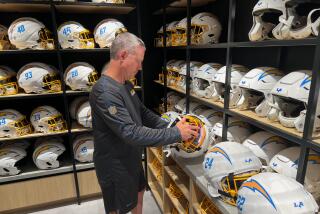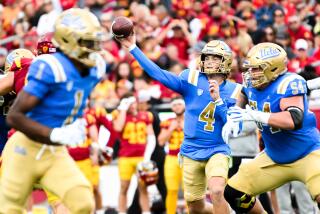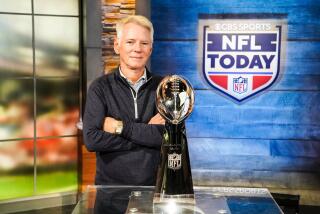SUPER BOWL XXIX : Drug Testing in NFL Under a Microscope : Pro football: Health officials, former players question efforts to detect steroids as athletes continue to get bigger, stronger.
- Share via
Last year, in the spired, medieval European capital of Prague, an insight into American professional football was revealed without so much as a shudder back home.
During an international conference on anabolic steroids, a U.S. federal agent discussed his interrogation of Eric Moore, a New York Giant offensive lineman who pleaded guilty to a misdemeanor charge of possession of steroids in June.
Moore told the agent that he was usually given advance warning of any test, the centerpiece of the NFL’s drug program. Moore said he was allowed to enter the testing room alone and that he kept a clean vial of urine in his jock strap to substitute for his own specimen.
Moore, suspended the first four games of this season because of the drug conviction, was never caught by the NFL.
Few ever are.
The NFL increased its steroid tests from 6,000 to 10,000 this season and announced only one positive, running back Frank Wycheck of the Washington Redskins. Yet players appear to be getting bigger, stronger and faster as the sport careens toward the 21st Century seemingly without tackling the underlying issues behind drug use.
It is suggested that the NFL is in denial.
When recently asked about drugs in the NFL, Tim Green, once an Atlanta Falcon defensive end, was at first adamant the testing program was working effectively.
“I can’t imagine what else they could do,” said Green, now an author living in upstate New York after being released in 1993.
“My personal experience with that test has been. . . .”
Green paused.
“When you think about it, sure you could get around it,” he said with sudden realization. “I could remember sometimes saying to the guy, ‘I’ve already used the bathroom this morning and you’ll have to get me tomorrow.’ ”
Circumventing the system is as old as testing itself. But the anecdotal evidence is not enough for blanket indictment. Not compared to baseball or hockey, where the steroid issue has yet to be seriously addressed.
Anabolic steroids are synthetic derivatives of the male sex hormone, testosterone, and are said to promote muscle mass. They are banned in the NFL, the NCAA and the Olympics.
The NFL’s program, which for the first time this year includes out-of-season random testing, seems to have curtailed steroid use but by how much no one knows.
Some ask why it matters because steroids are as passe as cassette tapes. And that’s a problem for any sports organization that, if for no other reason than a good image, tries to fight the war on performance-enhancing drugs.
With so much emphasis on catching steroid cheaters, sports officials have done little to deter the so-called designer drugs currently undetectable.
The drug of choice is said to be the human growth hormone (HGH) although, like anabolic steroids, there is no scientific proof that it is being abused.
“We don’t know what’s going on in the NFL,” said Charles Yesalis, professor of health and human development at Penn State. “We haven’t done a study. Who’s going to cooperate with you?”
Not the NFL, even though it has greatly enhanced its drug detection program in the last few years. John Lombardo, the NFL’s drug adviser for performance aids, was not made available to be interviewed.
“We have the most comprehensive (drug) program in sport,” said Greg Aiello, NFL director of communications. “Of course, we’re not naive enough to think we’re 100% clean.”
Nor is the NFL being 100% honest if the federal agent in Prague is to be believed. The Eric Moore experience left some investigators suspicious of pro football’s intentions. Some thought NFL security got involved when Moore and Mark Duckens of the Tampa Bay Buccaneers were indicted on drug charges for damage control more than a moral obligation to assist a federal investigation involving the league.
Where is this leading?
If players are using HGH, there is little the testers can do to prove it. The naturally produced substance cannot be detected and until such a test exists, sports officials are helpless to control its use.
It might be too late. The bodybuilding community says that HGH is already on the way out for IGF 1, insulin growth factor 1, an undetectable hormone that acts on skeletal muscle and does not affect other organs.
Anthony Munoz, former Cincinnati Bengal lineman, noted that the size of players’ arms and chests has increased since his Pro Bowl days, even though weight room hours are about the same.
“Guys weren’t getting 20-inch arms, looking like they were cut out of granite,” said Munoz, who supports the NFL’s program.
These chiseled physiques foreshadow a bleak future for advocates of naturally strong athletes. Sometimes, bigger and stronger is the difference between making a team and being cut. Sometimes, it is the difference between being a superstar and not.
“So much of who you are is wrapped around what you do on the football field,” Munoz said.
“The crazier they are, the bigger stars they are,” said Robert Huizenga, formerly a Raider physician. “Who’s going to stop using drugs if drugs make you so wacky that you get all the press and then the bigger endorsements?”
So the players are seduced then ensnared. “One of the biggest lies pro athletes buy into is that by taking steroids it’s going to allow you to keep your job,” Munoz said.
Little did it seem to matter that one of their brethren, Lyle Alzado, died kicking and screaming that performance-enhancing drugs killed him.
And with superhuman performances on the field bringing more and more fans to the stadiums, more and more endorsements and ever-increasing salaries, the gladiators will continue to poke themselves with syringes, ingest little miracle pills and try to find that extra edge.
And before our eyes they will continue to grow like Jack’s beanstalk. They will grow into towering permutations until the body finally refuses to bulge one more centimeter.
With few advances in strength training and nutrition in the last seven years, Penn State’s Yesalis wonders how these players are doing it if they and the NFL say drug use has decreased.
“God has not changed the recipe for humans,” he said.
Not yet, anyway. If bigger means better and there is even more money to be gained, why not true genetic engineering for our football heroes of the next century? Why not 9-foot, 600-pound linemen with 40-yard dash times comparable to the current players?
That might seem far-fetched. But when a lineman runs down a linebacker who intercepted a pass as happened this season, it is easy to be skeptical of the NFL’s drug-testing program.
“I’m just not one of those standing on the sideline with pompons saying, ‘Oh, boy, you’ve really cleaned this up,’ ” Yesalis said. “I don’t believe it.”
More to Read
Go beyond the scoreboard
Get the latest on L.A.'s teams in the daily Sports Report newsletter.
You may occasionally receive promotional content from the Los Angeles Times.










